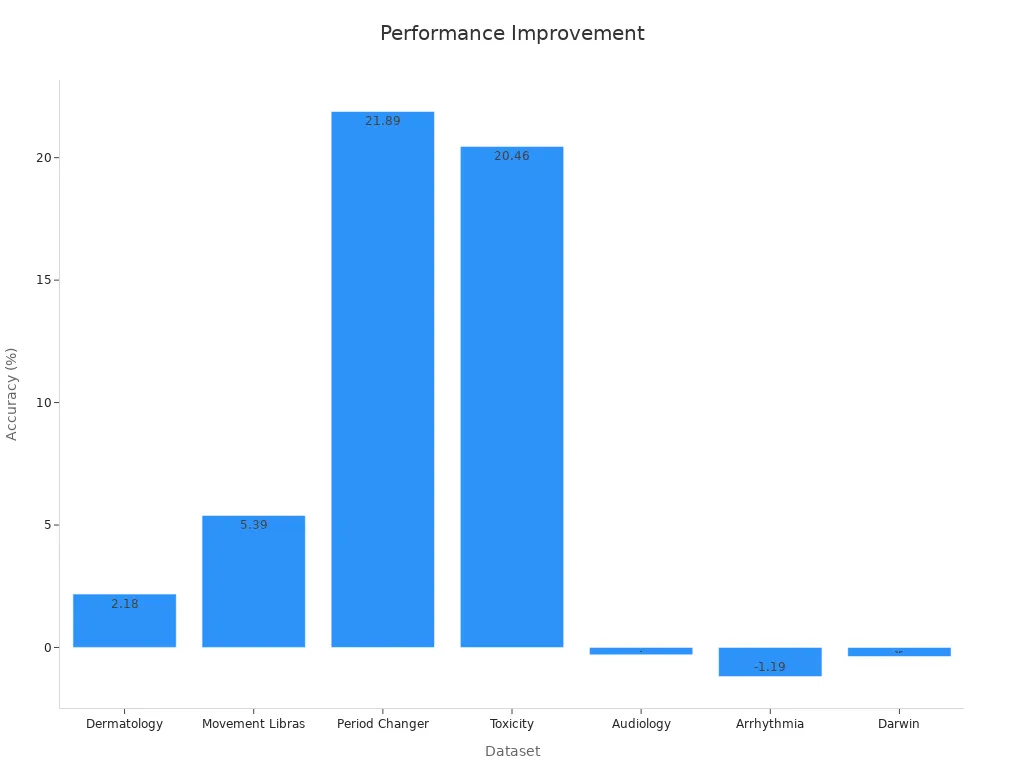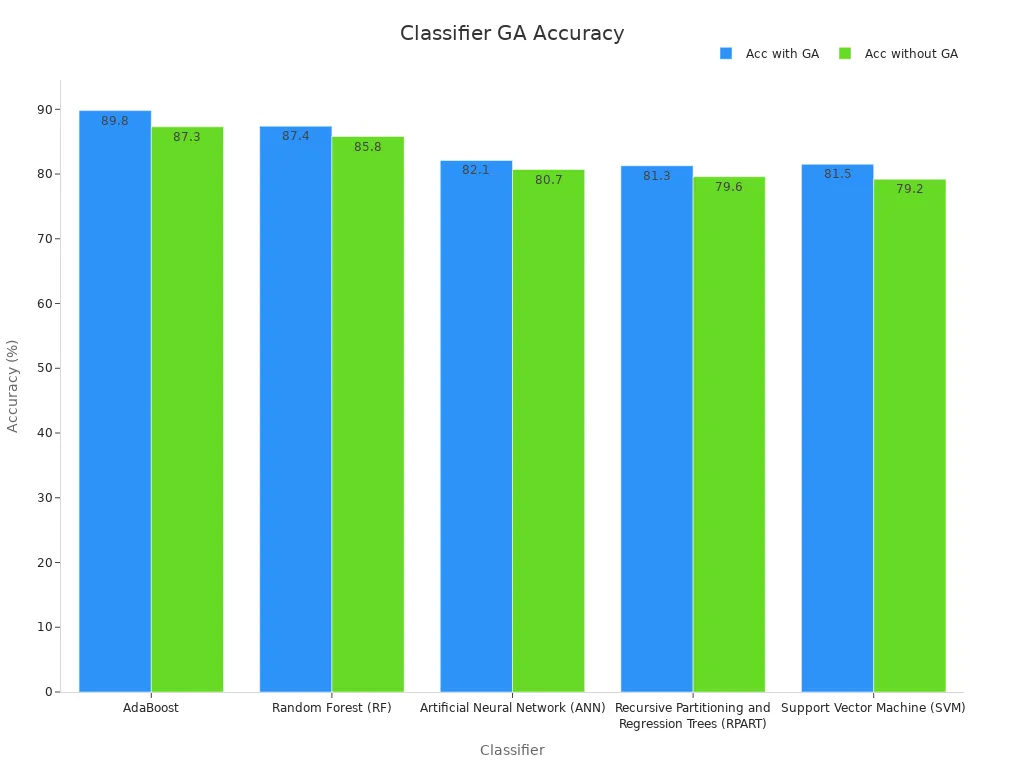
A factory uses machine vision technology to inspect products on a conveyor belt. The Genetic Algorithm machine vision system chooses the best image enhancement operators, leading to high optimization and better inspection results. This system improves efficiency by reducing the time needed for multilevel thresholding. Machine vision systems benefit from optimization, as genetic algorithms find global solutions and increase segmentation accuracy. These systems also optimize cluster centers more effectively than traditional methods. The result is higher efficiency and stronger machine vision performance across the entire system.
Key Takeaways
- Genetic algorithms improve machine vision by finding the best solutions quickly and avoiding poor results.
- These algorithms help select important features and tune settings, which boosts accuracy and speeds up processing.
- Machine vision systems using genetic algorithms perform better in industries like factory inspection, traffic detection, and medical imaging.
- Genetic algorithms balance accuracy and efficiency but may need more computing power and time for complex tasks.
- Future machine vision will grow stronger by combining genetic algorithms with other smart methods to solve harder problems faster.
Genetic Algorithm Machine Vision System
What Is a Genetic Algorithm?
A genetic algorithm is a type of computer program that solves problems by copying the way nature works. In nature, animals and plants change over time through natural selection. The strongest survive and pass on their traits. Genetic algorithms use this idea to find the best answers to hard problems.
The process starts with a group of possible solutions. Each solution is like a "chromosome." The system checks how good each solution is. The best ones are chosen to create new solutions. The system mixes and changes these solutions using steps called selection, crossover, and mutation. Over many rounds, the system finds better and better answers.
Researchers have shown that genetic algorithms can solve complex problems. They use these algorithms in artificial intelligence and machine learning. The system keeps improving solutions, just like nature helps animals adapt to their environment.
Genetic algorithms work well because they search through many possible answers. They do not get stuck on bad solutions. This makes them useful for machine vision technology, where finding the best answer is important.
System Integration
A genetic algorithm machine vision system uses these smart algorithms to improve how machines see and understand images. The system can choose the best settings for cameras, pick the most important parts of an image, and even design new ways to process pictures.
In factories, companies use machine vision technology to inspect products. For example, ILIB software uses a genetic algorithm machine vision system to find the best filters for image processing. The system tests many filters and keeps the ones that work best. Braintech Inc. uses a similar system in car factories. Their system can read mould numbers, find brake shoes, and check cylinder heads. These tasks need the system to be very accurate and fast.
Some systems use hybrid approaches. For example, BAS-GA combines the Beetle Antennae Search (BAS) algorithm with a genetic algorithm. This hybrid system can search for the best answers even faster. The system uses the strengths of both algorithms to solve problems that are too hard for just one method.
The genetic algorithm machine vision system also shows strong results in research. The table below shows how much these systems can improve accuracy and reduce the number of features needed:
| Dataset / Classifier | Accuracy Improvement Range (%) | Feature Reduction (%) | Additional Notes |
|---|---|---|---|
| Dermatology | +2.18 | N/A | Accuracy 98.90% achieved by RFIGA, surpassing baseline |
| Movement Libras | +5.39 | N/A | Accuracy 69.00% by RFIGA, surpassing baseline |
| Period Changer | +21.89 | >90% | High-dimensional dataset, RFIGA accuracy 83.00% |
| Toxicity | +20.46 | >90% | High-dimensional dataset, RFIGA accuracy 73.73% |
| Audiology | -0.3 (vs IGA) | +2% | Slightly less accurate than IGA but better feature reduction |
| Arrhythmia | -1.19 (vs IGA) | +15% | Accuracy slightly lower than IGA, feature reduction significantly higher |
| Darwin | -0.37 (vs IGA) | +6% | Accuracy slightly lower than IGA, more features eliminated |
| SVM Classifier | +4.12 to +35.09 | >50% | Consistent accuracy improvement across datasets |
| Ridge Classifier | +0.12 to +33.29 | >50% | Consistent accuracy improvement across datasets |
| Naive Bayes (NB) | +3.46 to +62.40 | >50% | Highest accuracy improvement observed |
| KNN Classifier | +7.15 to +24.84 | >50% | Consistent accuracy improvement |
| Convergence Speed | Faster convergence than other algorithms | N/A | Fitness curves decline more rapidly, indicating better optimization efficiency |

The genetic algorithm machine vision system helps the system find answers quickly and with fewer mistakes. The system can handle large amounts of data and many possible solutions. This makes the system a strong choice for machine vision tasks in many industries.
Machine Vision Optimization
Feature Selection
Feature selection plays a key role in machine vision optimization. The system must choose the most important features from large sets of data. Genetic algorithms help the system search for the best feature combinations. The system uses a fitness function to measure how well each feature set improves recognition and accuracy. By removing extra or irrelevant features, the system reduces data size and speeds up processing. This step also lowers the risk of overfitting, which means the system will perform better on new data. The system can handle high-dimensional data and still find the best features for recognition tasks.
The system’s ability to focus on relevant features leads to higher accuracy and better performance in machine vision applications.
| Metric / Aspect | Summary |
|---|---|
| Detection Accuracy | The system achieves higher accuracy by selecting optimal features. |
| Dimensionality Reduction | The system removes unnecessary features, reducing data and computational cost. |
| False Positives & Negatives | The system lowers errors, improving recognition results. |
| Computational Efficiency | The system searches large data spaces quickly and efficiently. |
Parameter Tuning
Parameter tuning is another important part of optimization in machine vision. The system must set the best values for model parameters to improve recognition and accuracy. Genetic algorithms explore many possible parameter settings. The system encodes these settings and tests them to find the best combination. In one study, the system used genetic algorithms to tune parameters like learning rate and tree depth. The system improved accuracy from 0.82 to 0.978 and increased performance in precision and recall. This process helps the system avoid overfitting and ensures strong results on new data.
Model Training
Model training brings together feature selection and parameter tuning. The system uses genetic algorithms to optimize the training process. The system tests many models with different features and parameters. The system selects the best models based on recognition accuracy and performance. The system can solve complex optimization problems, even when the data space is large and nonconvex. In robot path planning, for example, the system uses machine vision to collect data, extract features, and then applies genetic algorithms to optimize the robot’s path. The system achieves high positioning accuracy and fast recognition, even in challenging environments.
Genetic algorithms give the system the power to solve tough optimization problems in machine vision, leading to better recognition, higher accuracy, and improved performance.
Applications of Genetic Algorithm

Industrial Inspection
Factories rely on machine vision systems to maintain high product quality. These systems use genetic algorithms to select the most important features from large sets of data. The system improves quality inspection by focusing on features that best separate good products from defective ones. For example, a robotic sorting system can use genetic algorithms to choose the right image processing filters, making it easier to spot flaws on a production line.
- Genetic algorithms help the system handle noisy and high-dimensional data, which often appears in manufacturing environments.
- The system combines genetic algorithms with decision tree classifiers to boost predictive accuracy.
- Metrics such as F1 score, BLEU score, and cosine similarity measure how well the system performs on unbalanced and noisy data.
- The system improves quality by reducing false positives and negatives during inspection.
- Statistical analyses show that combining genetic algorithms with supervised learning models leads to better failure prediction in semiconductor manufacturing.
The system’s ability to select informative features and improve classification accuracy makes it a valuable tool for quality control.
Traffic Detection
Traffic detection systems must process large amounts of data quickly and accurately. Genetic algorithms help these systems by optimizing feature selection and tuning classifier parameters. The system can reduce the number of features needed while still achieving high recognition accuracy. For example, a traffic detection system using a genetic algorithm reached 98% accuracy on the KDD dataset with only 16 features.
Research shows that genetic algorithms improve detection accuracy and efficiency in traffic systems. The system can handle data imbalance and feature redundancy, which are common in real-world traffic scenarios. By using a novel fitness function, the system balances classification accuracy, feature redundancy, and F1 score. This approach leads to better real-time decision-making and more stable detection results.
Traffic detection systems benefit from genetic algorithms by achieving higher accuracy, faster convergence, and improved robustness.
Medical Imaging
Medical imaging systems require high accuracy and reliability. Genetic algorithms play a key role in improving recognition and diagnosis. These systems use genetic algorithms to select the best features from complex imaging data, such as CT scans or MRI images. For example, an AI model using genetic algorithms achieved high sensitivity and specificity in detecting large vessel occlusions, helping doctors make timely decisions for stroke patients.
Medical imaging systems also combine genetic data with imaging data to improve disease risk prediction. The Taiwan Biobank, for instance, uses genetic algorithms to analyze both genetic markers and imaging data, leading to better predictions for diseases like Type 2 diabetes. The system uses advanced machine learning models, such as Extreme Gradient Boosting, to further enhance accuracy.
Robust data handling and bias mitigation techniques, such as data rebalancing and synthetic data generation, support the system’s performance. These methods ensure fairness and accuracy in clinical settings. The system uses performance metrics and transparency tools to monitor and refine its results, leading to better diagnostic outcomes.
Image Segmentation
Image segmentation divides an image into meaningful parts, which is essential for recognition tasks in machine vision. Genetic algorithms help the system find the best way to separate objects from the background. The system uses clustering and shape analysis to improve segmentation quality.
For example, in quality inspection, the system uses genetic algorithms to cluster pixels and identify defects in products. The system can also segment medical images to highlight tumors or other areas of interest. Genetic algorithms search through many possible segmentations, selecting the one that maximizes recognition accuracy and quality.
| Classifier | Accuracy with GA (%) | Accuracy without GA (%) |
|---|---|---|
| AdaBoost | 89.8 | 87.3 |
| Random Forest (RF) | 87.4 | 85.8 |
| Artificial Neural Network (ANN) | 82.1 | 80.7 |
| Recursive Partitioning and Regression Trees (RPART) | 81.3 | 79.6 |
| Support Vector Machine (SVM) | 81.5 | 79.2 |

The table and chart above show that genetic algorithms consistently improve accuracy across different classifiers. The system achieves better recognition by selecting optimal feature subsets, which leads to higher quality results in image processing tasks.
Genetic algorithms support automation in machine vision by enabling systems to adapt to new data and changing environments. The system’s ability to optimize feature selection, clustering, and shape analysis makes it a powerful tool for quality inspection, medical diagnostics, and traffic detection.
Benefits and Challenges
Advantages
Genetic algorithms bring many advantages to machine vision. The system uses optimization to search for the best solutions in large and complex data spaces. This approach helps the system avoid getting stuck on poor answers and improves both accuracy and quality. The system can adapt to new problems by changing its search strategy, making it flexible for different tasks.
- The system increases efficiency by testing many possible solutions at once. This saves time and boosts production efficiency in real-world settings.
- The system uses advanced optimization strategies, such as elite selection and local search, to improve results and reduce the search space.
- Studies show that the system achieves higher accuracy and quality in image segmentation, especially in medical imaging and digital pathology.
- The system maintains diversity in its solutions, which helps avoid premature convergence and leads to better performance.
- The system outperforms traditional clustering and segmentation methods, reaching optimal or near-optimal solutions in hard problems.
Genetic algorithms help the system balance accuracy, efficiency, and quality, making them a strong choice for machine vision optimization.
Limitations
Despite these strengths, the system faces some challenges. The optimization process can require high computational resources, especially when the system works with large datasets or complex images. The system may take longer to reach the best solution compared to simpler methods.
- The system sometimes struggles with convergence speed, especially in tasks that need quick results.
- Integrating the system with other AI methods, such as deep learning, can be difficult and may require extra tuning.
- The system’s improved strategies, like advanced selection and crossover, can increase computation time, even though they boost accuracy and quality.
- In some cases, the system must balance resource use with the need for high performance, especially in real-time applications.
The system’s robustness and high precision make it valuable, but users must consider the trade-off between efficiency and computational cost.
Future of Machine Vision
Innovations
Machine vision continues to grow as new innovations appear. Researchers now combine genetic algorithms with machine learning to create smarter systems. One case study shows that a system can use machine learning to adjust genetic algorithm settings while solving image reconstruction problems. This hybrid system improves both the quality of solutions and the speed at which the system finds answers. The system outperforms other methods, such as Tabu Search and Artificial Immune Systems, in these tasks.
Hybrid systems help the system solve complex, high-dimensional, and nonlinear problems in machine vision. These systems can handle large amounts of data and adapt to new challenges quickly.
Many companies now use these advanced systems in real-world settings. For example, a system can inspect products on a factory line or analyze medical images for doctors. The system learns from data and keeps improving its performance over time.
Research Trends
Researchers focus on making the system faster and more efficient. They study how the system can avoid getting stuck on poor solutions, which is called premature convergence. The system sometimes needs to balance exploring new solutions and using the best ones found so far. Adaptive mutation rates and crossover operators help the system keep searching for better answers.
- The system faces challenges with computational cost, especially when working with large data sets.
- The system must choose the right chromosome encoding for each problem, such as binary or real-valued.
- The system often needs domain knowledge to set up good fitness functions and genetic operators.
- The system uses penalty functions and repair methods to handle real-world constraints and keep solutions feasible.
Researchers also use parallelization and hybridization to reduce the time the system needs to process data. These trends help the system handle more complex tasks and larger data sets in the future.
Genetic algorithms help machine vision systems solve hard problems. They improve accuracy, speed, and adaptability in many industries. These systems find better solutions for tasks like inspection, detection, and medical imaging.
- Many companies use genetic algorithms to boost quality and efficiency.
- Researchers keep finding new ways to make these systems smarter.
Machine vision will keep growing as genetic algorithms become more advanced. The future looks bright for both research and real-world use.
FAQ
What makes genetic algorithms useful in machine vision?
Genetic algorithms help machine vision systems find the best solutions quickly. They test many options at once. These algorithms improve accuracy and efficiency in tasks like image segmentation and feature selection.
Can genetic algorithms work with deep learning models?
Yes. Genetic algorithms can tune parameters and select features for deep learning models. This combination helps the system learn faster and perform better on complex image tasks.
How do genetic algorithms handle large datasets?
Genetic algorithms search through large datasets by testing many solutions in parallel. They remove unnecessary features and focus on the most important data. This process saves time and improves results.
Are genetic algorithms only used in factories?
No. Genetic algorithms help in many fields. They support medical imaging, traffic detection, and quality inspection. These algorithms adapt to different problems and environments.
Do genetic algorithms always give the best answer?
Genetic algorithms often find very good answers, but not always the absolute best. They avoid getting stuck on poor solutions. The system usually reaches a solution that works well for real-world needs.
See Also
Understanding The Use Of Synthetic Data In Vision Systems
How Guidance Machine Vision Enhances Robotics Performance
An Introduction To Sorting Systems Using Machine Vision
A Clear Explanation Of Computer And Machine Vision Models
Comparing Firmware-Based Vision With Traditional Machine Systems








